Red tail Hemiodus tetra at Fish Story
- Thread starter thebiggerthebetter
- Start date
I am very surprised to hear of aggression among the Hemiodus. I have never had a large group as yours.
I also have not had H. gracilis but I have 5 that I believe may be H. orthonops. These grow larger than gracilis (my 3 adults are about 8”); I see competition and sometimes minor bickering but no aggression, even though they are in a small tank (125g).
Of the 3 of yours that died, one was skinny and somewhat deformed. His death may not have been through aggression. The apparent missing scales in all three fish could have happened postmortem, as well as the chewed tails. But of course I can’t know. Just stating the possibility.
A guy here (ChetE) keeps several Hemiodontidae and is quite knowledgeable of these fish. I wonder if he has experienced aggression with his fish.
I love the group! Thanks for sharing.
I also have not had H. gracilis but I have 5 that I believe may be H. orthonops. These grow larger than gracilis (my 3 adults are about 8”); I see competition and sometimes minor bickering but no aggression, even though they are in a small tank (125g).
Of the 3 of yours that died, one was skinny and somewhat deformed. His death may not have been through aggression. The apparent missing scales in all three fish could have happened postmortem, as well as the chewed tails. But of course I can’t know. Just stating the possibility.
A guy here (ChetE) keeps several Hemiodontidae and is quite knowledgeable of these fish. I wonder if he has experienced aggression with his fish.
I love the group! Thanks for sharing.
Thank you much FJB!
More later when I have time.
***
5th dies, 6th dies - this was a week ago. No deaths or obvious signs of attacks since then. No change in the tank at all. The killings just stopped.
More later when I have time.
***
5th dies, 6th dies - this was a week ago. No deaths or obvious signs of attacks since then. No change in the tank at all. The killings just stopped.
Very unfortunate loses. I don't have any insight.
However, I do believe you have 2 species in the surviving group: i) the "red tail Hemiodus" (almost certainly H. gracilis). These are most of the specimens in the videos. Then, ii) another species with two defining characters: incomplete black stripe from mid-body to tail, and no red on caudal fin (very white instead); the fish is also more robust (thick). I only see one specimen that I think belongs to that second species, but it is hard to tell. The two shots below come from the last video, at 3:42 and 4:06 respectively.
From your video (apologize for quality of clips, not of the video):
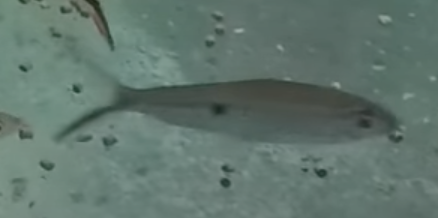
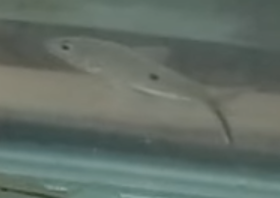
Several things make identification of Hemiodus very difficult: Generally, we don't know the localities they come from; also, there are a number (10-15) similar-looking species, all relatively poorly known, and some are sympatric (exist in the same locality); also, some of the defining characters (extend of black bands or spots, presence of red on caudal fin) are mood-dependent, developmental (age)-dependent, and potentially also affected by individual variation, and both gender-based, and dominance status variation.
I have what I believe are two species, together in a 125g-
- 3 large specimens (perhaps H. orthonops or similar), characterized by almost never complete black stripe (instead, just a large dot at mid-body and rest of body completely silver), and mainly no red on tail, white instead. However, as these specimens grew from 3.5-3" to now ~7-8" (I believe they are done growing), red appeared on part of the tail (both upper and lower lobes) in a permanent manner (both upper and lower body), albeit much less (size of colored area and intensity) than in H. gracilis. Also, in a mood dependent fashion, the single black dot mid-body can develop into a nearly complete black line (most often greyed-out as a 'ghost' stripe), which can change later or next day when mood changes, by intensifying or disappearing. These ghost dark bands are hard to catch in pictures. I have had these fish for about 5 years.
- The second species (2 fish, ~3") have a more permanent black stripe (although there is also a marked dot mid-body), and no red at all on fins, white/silver instead at the two edges of the lower caudal lobe. Of course I do not know how they will change with age, and also don't know how large they will become. I have had these fish for ~ 1.5 years (originally 4, I lost 2 to jumping and to my stupidity).
I don't intent to do piracy to your thread, rather to offer images of my fish for comparison and discussion.
The 3 large specimens first (two visible),
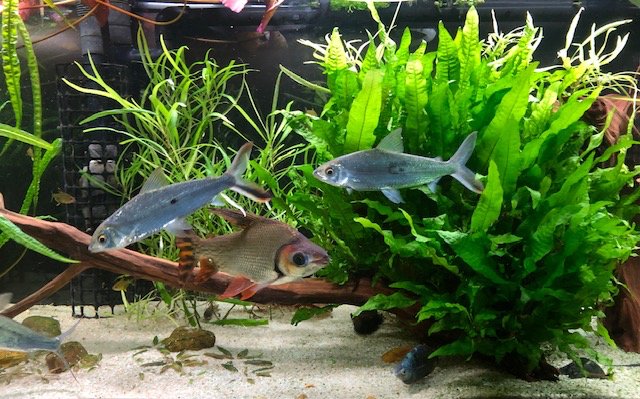
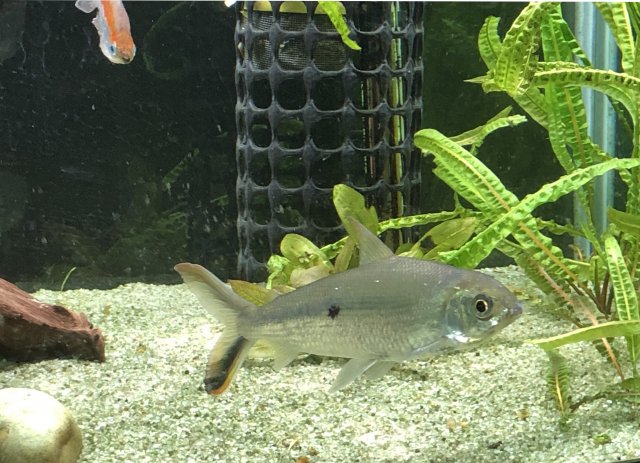
and just for kicks! (they are fast!)
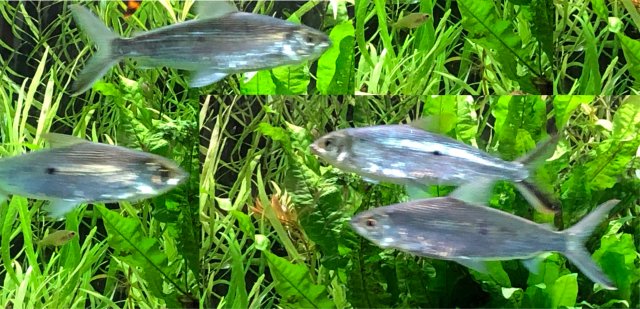
Composition of one of the two smaller fish ('sp. 2').
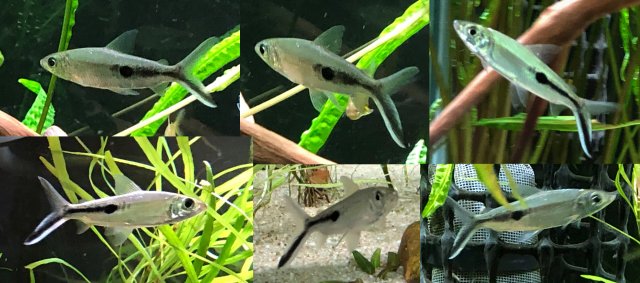
Cheers and thanks for sharing.
However, I do believe you have 2 species in the surviving group: i) the "red tail Hemiodus" (almost certainly H. gracilis). These are most of the specimens in the videos. Then, ii) another species with two defining characters: incomplete black stripe from mid-body to tail, and no red on caudal fin (very white instead); the fish is also more robust (thick). I only see one specimen that I think belongs to that second species, but it is hard to tell. The two shots below come from the last video, at 3:42 and 4:06 respectively.
From your video (apologize for quality of clips, not of the video):


Several things make identification of Hemiodus very difficult: Generally, we don't know the localities they come from; also, there are a number (10-15) similar-looking species, all relatively poorly known, and some are sympatric (exist in the same locality); also, some of the defining characters (extend of black bands or spots, presence of red on caudal fin) are mood-dependent, developmental (age)-dependent, and potentially also affected by individual variation, and both gender-based, and dominance status variation.
I have what I believe are two species, together in a 125g-
- 3 large specimens (perhaps H. orthonops or similar), characterized by almost never complete black stripe (instead, just a large dot at mid-body and rest of body completely silver), and mainly no red on tail, white instead. However, as these specimens grew from 3.5-3" to now ~7-8" (I believe they are done growing), red appeared on part of the tail (both upper and lower lobes) in a permanent manner (both upper and lower body), albeit much less (size of colored area and intensity) than in H. gracilis. Also, in a mood dependent fashion, the single black dot mid-body can develop into a nearly complete black line (most often greyed-out as a 'ghost' stripe), which can change later or next day when mood changes, by intensifying or disappearing. These ghost dark bands are hard to catch in pictures. I have had these fish for about 5 years.
- The second species (2 fish, ~3") have a more permanent black stripe (although there is also a marked dot mid-body), and no red at all on fins, white/silver instead at the two edges of the lower caudal lobe. Of course I do not know how they will change with age, and also don't know how large they will become. I have had these fish for ~ 1.5 years (originally 4, I lost 2 to jumping and to my stupidity).
I don't intent to do piracy to your thread, rather to offer images of my fish for comparison and discussion.
The 3 large specimens first (two visible),


and just for kicks! (they are fast!)

Composition of one of the two smaller fish ('sp. 2').

Cheers and thanks for sharing.
I am glad to report that in the last 2 weeks or so there have been no deaths among the Hemiodus or in the tank altogether.
Much appreciate your sharing your knowledge so generously and thoroughly, let it be Hemiodus or silver dollars (in my case). It's simply wonderful of you!
Yes, about a dozen or two of peers said they never experienced Hemiodus on Hemiodus deaths, but one or two people said they have (in the YT comments).
Right, the deaths I've seen here have been preceded by bodily damage, at first not too significant but seems to worsen a lot even if the affected fish is isolated, so the damage is latent.
Thank you for referencing C Chet E. I'd welcome his input and would love to learn from him too.
Yes, good eye, in the group of 32, well now 26, there is one fish with just a single large black dot, seems to be the H. orthonops same as yours. Moreover, there is a half a dozen of fish in the group with a bit different, more robust (or maybe they are simply older?) body build and no red - just black stripe exactly as the H. gracilis have, looks identical to your sp. 2 in the 3rd photo of your last 6 photos.
Wow, so much variability is possible. Thank you for the crash summary 101 on the Hemiodus, can't thank you enough.
Much appreciate your sharing your knowledge so generously and thoroughly, let it be Hemiodus or silver dollars (in my case). It's simply wonderful of you!
Yes, about a dozen or two of peers said they never experienced Hemiodus on Hemiodus deaths, but one or two people said they have (in the YT comments).
Right, the deaths I've seen here have been preceded by bodily damage, at first not too significant but seems to worsen a lot even if the affected fish is isolated, so the damage is latent.
Thank you for referencing C Chet E. I'd welcome his input and would love to learn from him too.
Yes, good eye, in the group of 32, well now 26, there is one fish with just a single large black dot, seems to be the H. orthonops same as yours. Moreover, there is a half a dozen of fish in the group with a bit different, more robust (or maybe they are simply older?) body build and no red - just black stripe exactly as the H. gracilis have, looks identical to your sp. 2 in the 3rd photo of your last 6 photos.
Wow, so much variability is possible. Thank you for the crash summary 101 on the Hemiodus, can't thank you enough.
Yep. I’ve been watching this thread! It is a nice display of fish.
.
Are Hemiodus a “problem fish”? I hope this thread will encourage others to enjoy Hemiodidae too. In watching the videos here, I see typical behavior for these fish settling into the new environs. Stress from a new environment is common with all wild caught fish. Adjusting to a new diet is a great hurdle. Gracilis are not too fussy about diet though and will soon refuse very little of the foods fed in their aquarium. They even eat pelleted foods. Stress has a lingering effect and I believe was manifesting itself in illness for your fish. Wild caught fish may have internal (gut) infections as well. Time heals all wounds?
.
Hemiodus, meaning half toothed (referring to them having teeth only in the upper jaw), may not have the dentition to effectively damage another fish. In the videos I see no indication of aggressive behavior. My experiences would indicate that the only aggression will be displays for dominance and/or courtship. When your fish start displaying towards each other, it’s interesting the color of the iris of their eye will become very dark. They will show off their fins. Rarely, they will ram each other which may dislodge scales randomly. There may be other changes to the body color pattern as well. Night time coloration is also different.
.
Yet there have obviously been losses. Damaged tails. Missing scales. But I'm glad to hear the losses have stopped.
.
One difficulty I’ve experienced is damage to their noses leading to infection. This infection can also attack the fins and generally starts on the tips progressing into the body. Hemiodus seem susceptible to this attack. Columnaris possibly? I dislike treating an environment for infection, but prefer to use a passive approach, stress reducers like clean water, dim lighting, addition of dithers, etc. (all of which you have in place), use of medicated foods, salt, and dyes like tannins, and increased temperature. I’d rather loose a few fish instead of the expense and risk of system crash from an antibiotic, for instance.
.
The “red-tailed Hemiodus” is a family of species or color variants which have in common that there is at least some red color on their tails. It is interesting that individuals within a species vary in how much red there is. The variety which I keep has more yellow than red. I’m not sure it matters in terms of aggression and health. I hope you will find them to be quite durable once they get settled in.
.
FJB , I also noted the lone mixed fish. Pretty neat!
.
Are Hemiodus a “problem fish”? I hope this thread will encourage others to enjoy Hemiodidae too. In watching the videos here, I see typical behavior for these fish settling into the new environs. Stress from a new environment is common with all wild caught fish. Adjusting to a new diet is a great hurdle. Gracilis are not too fussy about diet though and will soon refuse very little of the foods fed in their aquarium. They even eat pelleted foods. Stress has a lingering effect and I believe was manifesting itself in illness for your fish. Wild caught fish may have internal (gut) infections as well. Time heals all wounds?
.
Hemiodus, meaning half toothed (referring to them having teeth only in the upper jaw), may not have the dentition to effectively damage another fish. In the videos I see no indication of aggressive behavior. My experiences would indicate that the only aggression will be displays for dominance and/or courtship. When your fish start displaying towards each other, it’s interesting the color of the iris of their eye will become very dark. They will show off their fins. Rarely, they will ram each other which may dislodge scales randomly. There may be other changes to the body color pattern as well. Night time coloration is also different.
.
Yet there have obviously been losses. Damaged tails. Missing scales. But I'm glad to hear the losses have stopped.
.
One difficulty I’ve experienced is damage to their noses leading to infection. This infection can also attack the fins and generally starts on the tips progressing into the body. Hemiodus seem susceptible to this attack. Columnaris possibly? I dislike treating an environment for infection, but prefer to use a passive approach, stress reducers like clean water, dim lighting, addition of dithers, etc. (all of which you have in place), use of medicated foods, salt, and dyes like tannins, and increased temperature. I’d rather loose a few fish instead of the expense and risk of system crash from an antibiotic, for instance.
.
The “red-tailed Hemiodus” is a family of species or color variants which have in common that there is at least some red color on their tails. It is interesting that individuals within a species vary in how much red there is. The variety which I keep has more yellow than red. I’m not sure it matters in terms of aggression and health. I hope you will find them to be quite durable once they get settled in.
.
FJB , I also noted the lone mixed fish. Pretty neat!









